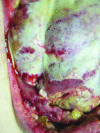Intraabdominal challenges affecting abdominal wall reconstruction
- PMID: 23372452
- PMCID: PMC3348746
- DOI: 10.1055/s-0032-1302459
Intraabdominal challenges affecting abdominal wall reconstruction
Abstract
Abdominal wall defects may arise from trauma, infection, and prior abdominal surgeries, such as tumor resections. Although ideally reconstruction should be accomplished as soon as possible to restore the integrity and function of the abdominal wall, it is not always a viable option. A successful reconstruction must take into consideration the local environment of the defect, as well as the global condition of the patient. Therefore, it is imperative that a multidisciplinary team be involved to optimize the patient's care, particularly when a defect is complicated by a wound infection, an abscess, a fistula, or a neoplasm. Our goal in this article is to explore the challenges evoked by each of these special situations, and review the necessary steps for successful management.
Keywords: abdominal wall reconstruction; enterocutaneous fistula; fistula; vesicocutaneous fistula.
Figures


Similar articles
-
Thoracoabdominal necrotising soft tissue infection secondary to enterocutaneous fistulae: a case report.J Wound Care. 2016 Oct 1;25(Sup10):S4-S7. doi: 10.12968/jowc.2016.25.Sup10.S4. J Wound Care. 2016. PMID: 27681810
-
Incisions and reconstruction approaches for large sarcomas.Transl Gastroenterol Hepatol. 2018 Oct 31;3:86. doi: 10.21037/tgh.2018.10.07. eCollection 2018. Transl Gastroenterol Hepatol. 2018. PMID: 30505973 Free PMC article. Review.
-
Use of a silver dressing for management of an open abdominal wound complicated by an enterocutaneous fistula-from hospital to community.J Wound Ostomy Continence Nurs. 2013 Jan-Feb;40(1):101-3. doi: 10.1097/WON.0b013e318279bfa5. J Wound Ostomy Continence Nurs. 2013. PMID: 23277219
-
Postoperative abdominal wall defects with enterocutaneous fistulae.Am J Surg. 1996 Oct;172(4):332-4. doi: 10.1016/S0002-9610(96)00201-2. Am J Surg. 1996. PMID: 8873524
-
Assessment and management of patients with intestinal failure: a multidisciplinary approach.Clin Exp Gastroenterol. 2018 Jun 12;11:233-241. doi: 10.2147/CEG.S122868. eCollection 2018. Clin Exp Gastroenterol. 2018. PMID: 29928141 Free PMC article. Review.
Cited by
-
Complex abdominal wall hernias as a barrier to quality of life in cancer survivors.Can J Surg. 2019 Mar 22;62(3):1-7. doi: 10.1503/cjs.014917. Online ahead of print. Can J Surg. 2019. PMID: 30900432 Free PMC article.
References
-
- Bradley E L Allen K A prospective longitudinal study of observation versus surgical intervention in the management of necrotizing pancreatitis Am J Surg 1991161119–24., discussion 24–25 - PubMed
-
- Rohrich R J Lowe J B Hackney F L Bowman J L Hobar P C An algorithm for abdominal wall reconstruction Plast Reconstr Surg 20001051202–216., quiz 217 - PubMed
-
- Lowe J B Updated algorithm for abdominal wall reconstruction Clin Plast Surg 2006332225–240., vi - PubMed

